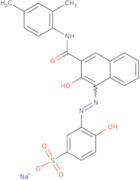Xylidyl blue I sodium salt
CAS: 14936-97-1
Rif. 3D-FX32392
| 1g | Fuori produzione | ||
| 2g | Fuori produzione | ||
| 5g | Fuori produzione | ||
| 10g | Fuori produzione | ||
| 25g | Fuori produzione |
Informazioni sul prodotto
- 1-(2-Hydroxy-5-sulfophenylazo)-2-hydroxy-N-(2,4-dimethylphenyl)-3-naphthamide sodium salt
- 1-Azo-2-hydroxy-3-(2,4-dimethylcarboxanilido)naphthalene-1-(2-hydroxybenzene)-4-sulfonate
- Benzenesulfonic acid, 3-[2-[3-[[(2,4-dimethylphenyl)amino]carbonyl]-2-hydroxy-1-naphthalenyl]diazenyl]-4-hydroxy-, sodium salt (1:1)
- Benzenesulfonic acid, 3-[[3-[[(2,4-dimethylphenyl)amino]carbonyl]-2-hydroxy-1-naphthalenyl]azo]-4-hydroxy-, monosodium salt
- Benzenesulfonic acid, 4-hydroxy-3-[[2-hydroxy-3-(2,4-xylylcarbamoyl)-1-naphthyl]azo]-, monosodium salt
- Magon sulfonate
- Sodium 1-azo-2-hydroxy-3-(2,4-dimethylcarboxanilido)naphthalene-1′-(2-hydroxybenzene-5-sulfonate)
- Xylidine Blue I
- Xylidyl Blue
- Xylidyl Blue I sodium salt
- Vedi altri sinonimi
- Xylylazo Violet 1
- Xylylazo Violet I
- sodium 3-[(2Z)-2-{3-[(2,4-dimethylphenyl)carbamoyl]-2-oxonaphthalen-1(2H)-ylidene}hydrazinyl]-4-hydroxybenzenesulfonate
- Sodium 3-((3-(((2,4-dimethylphenyl)amino)carbonyl)-2-hydroxy-1-naphthyl)azo)-4-hydroxybenzenesulphonate
Xylidyl blue I sodium salt is a fluorescent dye that has been used for light exposure of fetal bovine serum samples. It is also used in the preparation of cervical cancer cells and liver tissues. When exposed to ultraviolet light, it emits green fluorescence, which can be detected with an ultraviolet lamp. Xylidyl blue I sodium salt has been shown to inhibit cellular physiology by altering mitochondrial membrane potential in both cell lines and primary cells. This compound binds to the RNA polymerase enzyme and inhibits transcription, leading to a decrease in protein synthesis. The expression plasmid containing the gene encoding β-actin was used in transfection experiments on human kidney cells, liver cells, and urine samples. A monoclonal antibody against β-actin was also used to detect this protein in Western blot analysis of these same samples.





